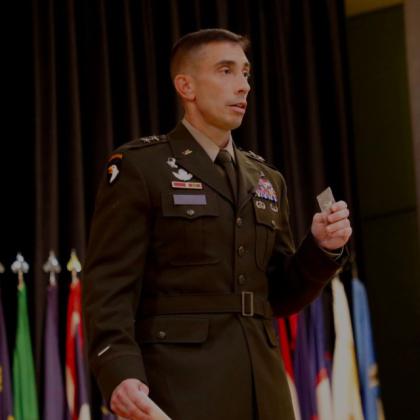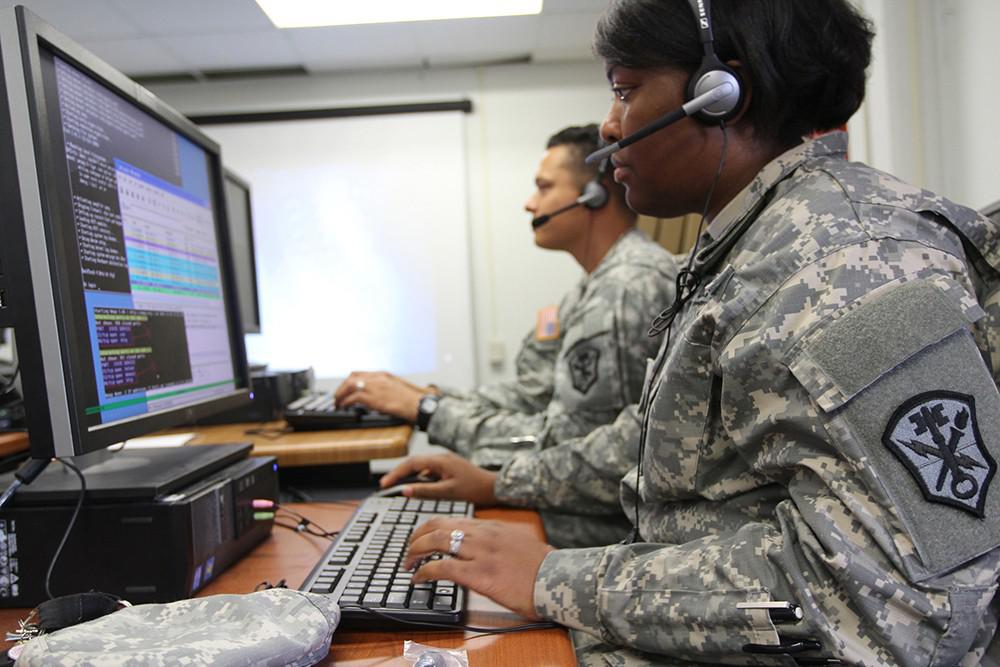Demand to Become a Cyber Warrior Remains 'Very' High
The next generation of Signal Corps, Cyber Corps and electronic warfare soldiers will have a much more complex environment in which to operate, facing the demands of a contested environment, widely dispersed across great areas and against highly skilled adversaries in cyber and electronic warfare. For cyber warriors in particular, Maj. Gen. Paul Stanton, USA, sees the demand to become cyber officers only increasing.
Gen. Stanton is the commanding general of Army Cyber Center of Excellence (CCoE) and the leader of Fort Gordon, Georgia—the installation that will be renamed Fort Eisenhower on October 27. The general spoke this week at AUSA’s annual conference in Washington, D.C. and to reporters during a roundtable discussion on October 12.
“We are in the ballpark of 10 to 1,” he explained. “For every one position that we have in the Officer Corps for a cyber soldier there are 10 candidates that want that job. Through our cyber proponent, Brig. Gen. [Brian] Vile, commandant of the Army Cyber Warfare School, and his team, we have a very active recruiting arm that goes to Reserve Officer Training Corps, to the United States Military Academy, to Officer Candidate School and searches out very highly qualified folks that want to join the cyber force.”
Holding a doctorate in computer science himself, Gen. Stanton is seeing college underclassman, who are interested in ‘being all they can be’ in the Army cyber realm already tailoring their curriculum and activities to be strong candidates as cyber officers.
“We have freshmen and sophomores in college that are demonstrating their intent and desire to join the cyber force and then aligning their course curriculum, ensuring a high GPA, and ensuring that they are well rounded leaders of character, because the selection process is incredibly competitive.”

We are in the ballpark of 10 to 1. For every one position that we have in the Officer Corps for a Cyber soldier, there are 10 candidates that want that job.
Inside the Army, shaping cyber officers for a complex future battlefield has propelled the Army to take several significant steps, including changing the number of military occupational specialties (MOSs) aligned with Signal formations, Gen. Stanton noted.
“Five years ago, we had 17 MOSs in the Signal Corps,” he said. “Today we have seven. ... The realization was that if you're going to operate in a unified network environment, you have to have a sufficient breadth to understand how data flows from a tactical edge environment and a sensor that's deployed on the battlefield all the way back into a cloud. You don't have to be an expert in each step of the data flow. But you have to understand that environment. We were over prescribed in how we were aligning our MOSs and based on now having seven, we've changed the curriculum and the programs of instruction that we use inside of the schoolhouse to align better to the future of a unified network.”
The CCoE also added a balance of functional courses to the schoolhouse training. “Three years ago, we didn't need a course on zero trust,” Maj. Gen. Stanton offered. “Today, we have one because we need operators at the division and below to understand zero-trust principles to understand the systems that they have and how to employ zero-trust principles with the systems that are available to them. And that requires a degree of education and training. And so we build functional courses to ensure that we will remain current as technology rapidly changes.”
The commanding general is also taking on the new chief of the Army’s call to reduce the complexity of systems. “I was really inspired by Gen. [Randy] George's comments, as our chief of staff of the Army, I felt like he was talking to me almost,” Gen. Stanton said. “We have to reduce complexity. We have to ensure that soldiers in contact have simple and intuitive systems with interfaces that they understand, that work when it is 32 degrees and raining outside and 0200 in the morning.”
The military head of the Army also emphasized the need for the ability of Army networks to be low signature, to be able to hide in plain sight, as far as spectrum emissions, considerations that Maj. Gen. Stanton echoed in importance. “Specifically in the areas of the network and electronic warfare, we need to be in a state of continuous transformation,” he stated. “We need a network that is low signature as the chief explained, and we need resilient, commander-to-commander communications. And from an electronic warfare perspective, yes, we want our systems to be low signature, but that's in the context of detectability. Think about what it means to raise the noise floor, to obscure our operations, and still hide in plain sight. The enemy may know in general where we're located but can't pinpoint our location.”
This means, however, that Signal, cyber and electronic warfare soldiers must be able to balance complicated operations across a network. “As the force modernization proponent for Signal, cyber and electronic warfare, I, as all senior leaders recognize, people are our asymmetric advantage, but we are presented with some challenges,” he noted. “When we make very simple interfaces for soldiers in contact, that doesn't remove all the complexity from our network operating environment. We just removed it from the soldiers in contact. We still need our Signal Corps, our Cyber Corps, to be well versed in multiple technologies simultaneously so that they can handle the configuration and operation of what is inherently a complex network.”
Moreover, Gen. Stanton understands that contributions that industry can possibly bring to help solve these complexities. He called for defense industrial base companies to create advanced spectrum, radio frequency and cyber solutions.
“Great discussions this week with industry partners that understand where that complexity will be placed and helping us to ensure that they design the right protocols and wave forms to enable our signal and cyber soldiers,” he said.
“Also inherent to large scale combat operations and the Army's ability to maneuver is relative advantage,” Gen. Stanton added. “We need to make better and faster decisions than our enemy. If we can introduce uncertainty and ambiguity into the enemy's decision cycle, even by a matter of minutes, we're giving our maneuver commanders the flexibility and agility to fight and win. So, in the context of discussing with many of our industry partners this week, what does it mean to create that degree of obscuration, such that maneuver commanders can fight. All of those things are directly aligned with the guidance that our secretary in chief outlined. And I'm happy that we're moving in a very positive direction.”






Comments